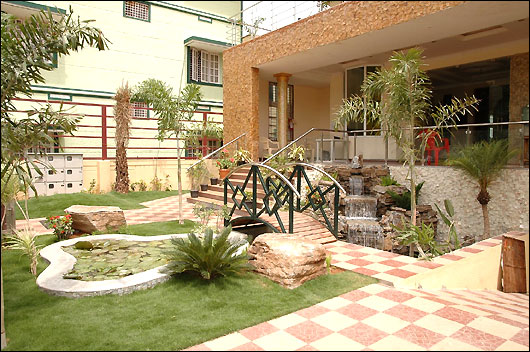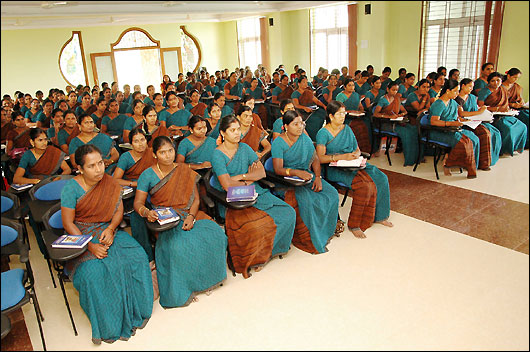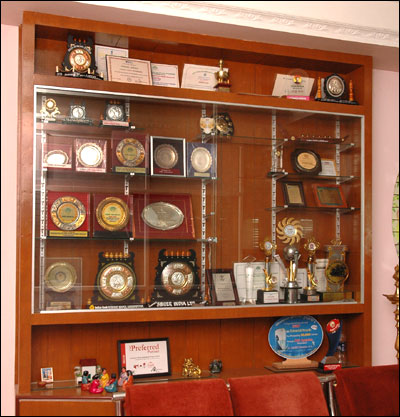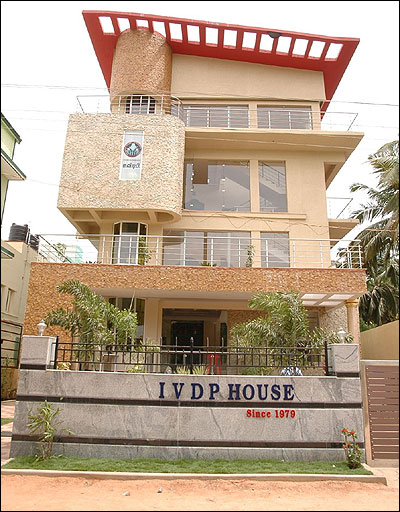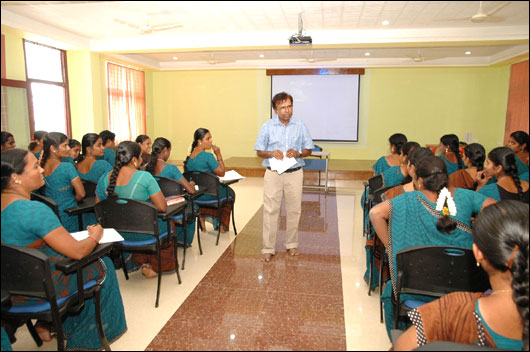 | « Back to article | Print this article |
Moving story of a Magsaysay winner
It had been only been a few days since the Magsaysay awards were announced but life was as usual for one of the winners. Not very surprising as Francis Kolandei, a name not many in India, let alone in Tamil Nadu, have heard of, prefers to work silently. In fact, he hadn't even heard of Magsaysay awards till he was told that he had won one.
He has been working for the last 33 years with the tribals living in the remotest parts of Tamil Nadu and later with the underprivileged women in some of the villages in Krishnagiri, Dharmapuri and Vellore districts, making them self sufficient.
Today, his organisation, Integrated Village Development Program (IVDP), an NGO, works with 8,231 Self Help Groups (SHGs) and 153,990 people.
IVDP has moved into their new sparklingly clean office only a month ago, and everyone, from the watchman to the women working in the office, is proud of it.
The day I went to meet Kolandei Francis in Krishnagiri, there was a monthly meeting of the 350 women who were in charge of the various SHGs. In uniform, they sat in the conference room. Chaired by Muniratnam, the chief coordinator, the meeting discussed the previous month's work and planned for the coming month.
Excerpts of the long chat I had with Kolandei Francis:
You had a tough childhood. Do you look back at those days?
How can I forget those days? I come from a very poor family in a remote place in Salem and my family went through unimaginable poverty. Ours was not an isolated case; many families in that area were extremely poor. Though we had a small piece of land, our parents worked as coolies in the farm land owned by others.
Later, my father got a job in the Railways as a gangman, and after that we moved with him to various places. But there was not enough money to even feed six children and two adults. But my mother had this desire to educate her children. Unfortunately, none of her children except me went beyond the 10th standard. It was not her fault. She tried to give education but they didn't make use of the opportunity. My mother was happy that at least one son of hers was interested in studying.
To send me to school and the University, my mother started small businesses like selling milk, rice, etc. I used to help her sell in the evenings after school. Life was so tough that everybody had to pitch in to make the family run.
When I was ready to go Annamalai University my mother decided to mortgage the small piece of land. By the time I finished college, my mother had lost the land as the moneylender cheated her.
Click on NEXT for more...
Moving story of a Magsaysay winner
Was it because your mother lost the only piece of land she had that later on, you chose to work with the poor who get cheated by moneylenders?
It was not just one incident but my entire childhood and the poverty we underwent had a strong impact on me. And that is why I decided to work with the poor who get cheated.
The hardship we went through cannot be explained in words. If I had not suffered the way I did, probably, I would not be doing what I am doing right now. I would have taken up a good job, got married and helped my mother like everybody else. That is the way each and every human being behaves. There is nothing wrong in that too.
But I was impacted by harsh poverty and I do not know whether it was a positive or negative impact.
Why did you opt for priesthood after your graduation?
After I graduated in 1969, I wanted to do social work. Coming from a Christian background, what came to my mind was to join priesthood. I thought I could help the poor only if I became a priest.
What was your mother's reaction when you took the decision?
She didn't like it a bit. She tried her best to dissuade me. She said she suffered a lot to educate me and I shouldn't be deserting the family. I told her that I could not be like everyone else and help only my own family. I didn't know whether I would be happy being useful only to my family.
Luckily for me, the moment I entered the seminary, my brother got a chance to work in Iraq, and that eased my guilt because I knew he would be able to help my family. She was happy that there was at least one person who would help the family.
Click on NEXT for more...
Moving story of a Magsaysay winner
While you were in the seminary, you were sent to help the refugees of the Bangladesh war. In what way did it affect you?
Yes, they sent me to help those affected by the war. I was on the Bangladesh border and there were many refugee camps there. The suffering and pain in the refugee camps had to be seen to be understood. Only those who witnessed it in person would know how bad the situation was.
After the kind of poverty we underwent, the sufferings I saw in the refugee camps also impacted me deeply.
Then and there, I started thinking whether I would be able to ease the suffering of such people as a priest.
I was sent from the seminary to do my Masters in Philosophy in Pune and soon after that, I was in the drought hit areas of Maharashtra. Once again, I saw human suffering in front of my eyes.
Looking back, I feel God wanted me to witness all kinds of human suffering so that I would be driven to do something to help people.
When did you decide to give up priesthood?
That was after I went to a very remote village. In 1975, I was sent to an interior village for one year. From Hosur, we travelled 75 kms to Anjetty, and from there, we walked 25 kms to reach almost the middle of a forest where many people lived.
Those people had migrated from near the Mettur dam when the British built it. I stayed there for a year. Another person from the seminary also was there with me.
The life in the village was very pathetic. There was no drinking water and starvation deaths also. There was no school, no hospital, no post office, no roads. If we wanted to travel out of the village, we had to walk 25 kms. If someone was very sick, he just died.
What did you do in the village to help them?
Children didn't study as there were no schools. So first, we started a night school for the children who went out in the day herding cows, sheep, buffaloes etc. We also started a first aid centre. During the day, we visited the homes and at night, taught the children.
I knew, as a priest, I would be expected to complete my studies and I would be sent to another place after some time but I wanted to do more for those villagers.
Another thing was, if I were a priest, people would have some pre-conceived notions about me. That was when the thought of coming out of priesthood struck my mind.
Click on NEXT for more...
Moving story of a Magsaysay winner
How tough was the decision?
It was a very tough decision. My mother initially disagreed with my decision to be a priest but she was aghast when I said I wanted to relinquish it. I told my mother not to worry about me or the people.
In 1979, I came back to the same place in the jungle, after relinquishing priesthood, to work for the people there. I continued with the night school and the first aid centre. Some people from the church helped me by providing food, shelter, clothing, books, etc. for the poor villagers. I established quite a few night schools in that area.
That was when Oxfam (Oxfam International is a confederation of 17 organisations working together to find lasting solutions to poverty and injustice) came to know about my work. They wanted to know what kind of help I needed. Other than the night schools and the first aid centres, I wanted to help the farmers who suffered from lack of water.
It was not that there was no rain there. Because it was a hilly area, all the rain water flowed away. I had earlier seen someone doing rain water harvesting in Karnataka. Similarly, I wanted to have small ponds and check dams in that area so that the villagers got water throughout the year.
How much difference did the check dams make?
Immediately after the check dams were built, the water table rose. Once there was more water, farming turned more dependable.
Is that when you decided to help them through loans?
They needed additional money for farming but no banks were willing to finance them. Even today, banks do not finance the poor. So you can imagine how it was in those days. There were poor people who mortgaged their land for many purposes to moneylenders and finally lost it.
If the villagers have to start anything, they need money.
Did you have any inspiration behind the model you worked on?
Having lived in a remote village, you have no inspiration except the needs of the people. I would say a series of events took place in my life and one led to the other.
Lack of water aggravated the poverty of the villagers. That is why we got water through check dams. Once you get water, you can start farming but you need money to start any kind of farming. So, that was the next step.
Click on NEXT for more...
Moving story of a Magsaysay winner
What was the financing model you followed?
There were 15-20 villages in the nearby area and altogether around 6,000 people. I formed men's groups. The reason behind making groups was if we give loans to individuals, they don't generally give the money back. In fact, first I started giving loans to individuals which was a failure.
We got around Rs 20 lakh (Rs 2 million) from Oxfam and we distributed it among the groups as loan of Rs 2,000, Rs 5,000 and Rs 10,000 which could be rotated and given to those families who didn't get loan first. People took these loans to buy seeds, pump sets, dig wells, etc. Once they harvested, they repaid the loan.
Though it worked well in the beginning, later, the men stopped paying back. They looked at it as easy money. What I started in 1981 went on till 1988, not that successfully, of course. In the end, we lost a few lakhs.
Is that the reason why you decided to work with women?
Yes. I didn't want to stop helping the people though it was a failure working with men. That was when I thought of trying the same pattern with women.
In 1989, I started with 10 women's groups of 15-20 women. But we told the women that we were not going to give them any loan but they had to start saving. They started with 50ps which became Re 1 and then Rs 5. We told them 50ps, Re 1 etc. is very little. So, quickly, the savings went up to Rs 10.
The money they collected was rotated among them as loan after a resolution in the group. The interest paid by the person who got the lump-sum amount was added to the group's funds.
You can call them self-help groups. That was how it all started. The money was not deposited in any bank at that time. It was not a co-operative as each group worked independently.
Click on NEXT for more...Moving story of a Magsaysay winner
So, it's not a micro-finance model?
No, it is not micro-finance. In micro-finance, somebody else lends the money and charges them interest. Here, the money is owned by the people themselves and the interest is also shared by the members.
That was the time Tamil Nadu government started a scheme linking self help groups to banks. That was ideal for us as we also needed bank loans.
After the groups deposited whatever they had saved, we got them loans of Rs.10,000, 15,000, 20,000, etc. The bank only charged 12 per cent interest from these people unlike the micro-finance model.
That is why I am not happy with the Bangladesh model of micro financing.
How different was working with women compared to men?
They are very disciplined and regular in collecting, disbursing and repaying money.
Had the money been given to men, they would have exhausted all that in no time. On the other hand, women makes use of it wisely. She sees to it that the family is fed properly, children are educated and well clothed and also money is saved. She thinks only of the family and not going to a liquor shop.
This way, we could put an end to poverty and child labour. The biggest change we saw was, children were going to school. Because children go to school, there are no child marriages.
A lot of our children, especially girl children, are going to Engineering and Medical colleges now.
Though our society is male centric, women are better managers of money. When money is given to the woman, she takes over the running of the family, that too in a better way. In front of our eyes, we saw their lives changing for the better.
When did you realise that the model you started was working?
When I saw a change in the lives of 300-400 families, I felt the model could be replicated. Now that we could a make a difference in the lives of more than a lakh and half people, you can say the model has been successful.
I am not talking about saving and giving loans alone. It is a holistic approach that we are following. I am talking about health, education, savings, etc.
I am happy that things are moving in the right direction.Click on NEXT for more...
Moving story of a Magsaysay winner
When did you come to know that you have won the Magsaysay award?
Actually, a few months back, some people came from the Philippines and they told me that they were research scholars. They were here for a few days speaking to me, the members, banks, etc. But I had no idea it was to evaluate us for the award that they were here. Only now, I realise that was their purpose.
How do you feel about getting such a prestigious award?
I don't know what to say. I never expected any award. I have been working for the last almost 35 years all alone, and I have undergone a lot of hardships in life. I never expected or looked for any awards in all these years. Awards have not changed me and will not.
It is the way my mother fought poverty that gives me the strength to wade through all difficulties. She is 94 now, and doesn't understand about awards but she understood that somebody had appreciated her son, and she was beaming, seeing my photo on TV.
Do you think the model you follow is the best one?
I will not say this is the only model but I would say this is much, much better than the micro-finance model. What we follow is a holistic approach.
I plan to work only with these many people but I hope others will take up this model, improve upon it and work in other areas where there are poor people.
